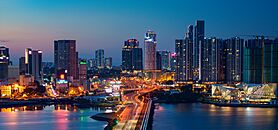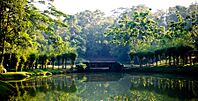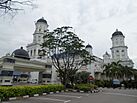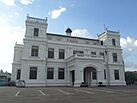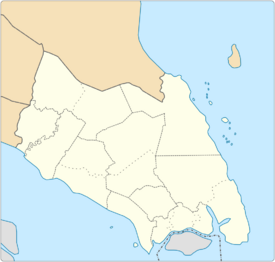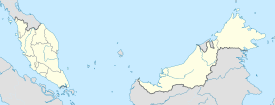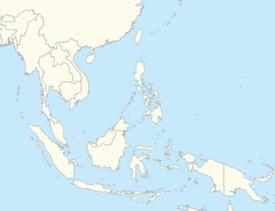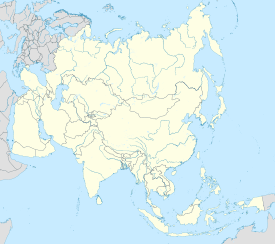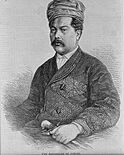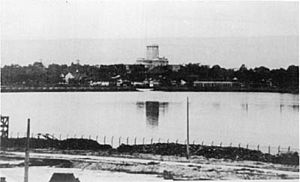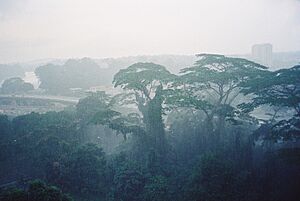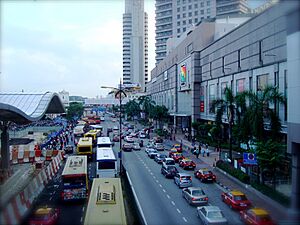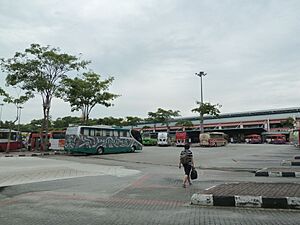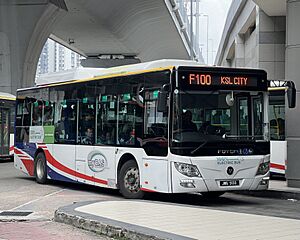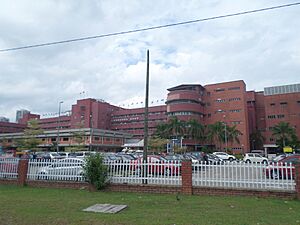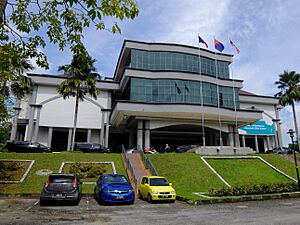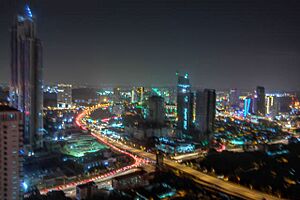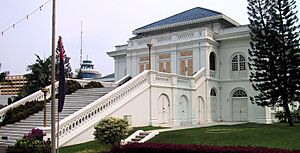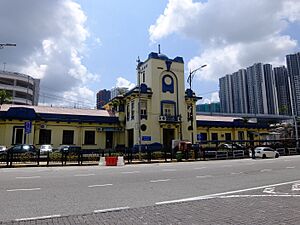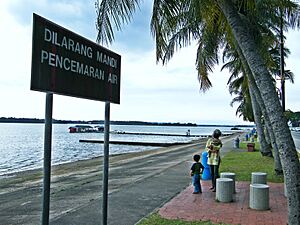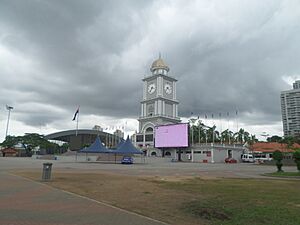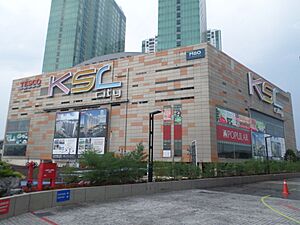Johor Bahru facts for kids
Quick facts for kids
Johor Bahru
|
|||
|---|---|---|---|
|
State capital city and district capital
|
|||
| City of Johor Bahru Bandaraya Johor Bahru |
|||
| Other transcription(s) | |||
| • Jawi | جوهر بهارو | ||
| • Chinese | 新山 (Simplified) 新山 (Traditional) Xīnshān (Hanyu Pinyin) |
||
| • Tamil | ஜொகூர் பாரு Jokūr Pāru (Transliteration) |
||
|
From top, left to right:
Downtown skyline at night, Johor-Singapore Causeway and Johor Bahru Sentral the transport hub in Southern Integrated Gateway, Skyline of the city centre, Forest City (Hutan Bandar) Recreational Park, Danga Bay, the Sultan Ibrahim Building, the Sultan Abu Bakar Mosque, and the Figure Museum |
|||
|
|||
| Nickname(s):
JB,
Bandaraya Selatan (Southern City) |
|||
| Country | |||
| State | |||
| District | |||
| Administrative areas |
List
|
||
| Founded | 10 March 1855 (as Tanjung Puteri) |
||
| Establishment of the local government | 1933 | ||
| Establishment of the Town Board | 1950 | ||
| Municipality status | 1 April 1977 | ||
| City status | 1 January 1994 | ||
| Government | |||
| • Type | City council | ||
| • Body | Johor Bahru City Council | ||
| Area | |||
| • Total | 391.25 km2 (151.06 sq mi) | ||
| Elevation | 32 m (105 ft) | ||
| Population
(2020)
|
|||
| • Total | 858,118 | ||
| • Density | 2,192/km2 (5,680/sq mi) | ||
| Demonym(s) | Johor Bahru | ||
| Time zone | UTC+8 (MST) | ||
| • Summer (DST) | UTC+8 (Not observed) | ||
| Postal code |
80xxx to 81xxx
|
||
| Area code(s) | 07 | ||
| Vehicle registration | J | ||
Johor Bahru (also called JB) is a major city in Malaysia. It is the capital city of the state of Johor. It is also the main city in the Johor Bahru District.
Johor Bahru is a very important city for Malaysia's economy. It is the second-largest city in Malaysia based on how much it adds to the country's wealth. The city is part of Iskandar Malaysia, which is a huge special economic zone.
The city is located at the very southern tip of Peninsular Malaysia. It sits along the Straits of Johor, right across from Singapore. Johor Bahru is one of the busiest border crossings in the world. Many people travel between Malaysia and Singapore here. The Johor–Singapore Causeway connects the two countries.
During the rule of Sultan Abu Bakar (1886–1895), Johor Bahru grew a lot. New buildings, schools, and railways were built. From 1942 to 1945, during World War II, Japanese forces took over Johor Bahru. After the war, in 1946, a big political party called the United Malays National Organisation (UMNO) was started here. Johor Bahru became a city in 1994.
Contents
What's in a Name?
The area where Johor Bahru is today was first a fishing village. It was called Tanjung Puteri. In 1858, Temenggong Daeng Ibrahim renamed it Iskandar Puteri.
Later, Sultan Abu Bakar changed the name to Johor Bahru. The word "Bahru" means "new" in Malay. So, Johor Bahru means "New Johor".
The city was also known as Shantou by its Chinese community. This was because many Chinese residents came from Shantou, China. Today, the Chinese generally call it Xinshan, which means "New Mountain". This name helped tell it apart from "Old Mountain" (Jiushan), which was used for areas in Singapore.
A Look Back in Time
In 1819, the Johor-Riau Sultanate split up. The mainland part of Johor came under the control of Temenggong Daeng Ibrahim. He wanted to create a new center for the Johor Sultanate.
In 1855, a deal was made between Sultan Ali and Temenggong Ibrahim. Ali became the Sultan of Johor. In return, he gave most of Johor to Temenggong Ibrahim. Temenggong Ibrahim then renamed the area Iskandar Puteri.
The area was mostly jungle back then. Temenggong Ibrahim encouraged people from China and Java to move there. They cleared the land to start farms. The Chinese grew black pepper and gambier. The Javanese dug canals and built roads. A Chinese businessman named Wong Ah Fook also arrived during this time.
After Temenggong Ibrahim passed away in 1862, his son, Abu Bakar, took over. The town was renamed "Johor Bahru".
British Influence
Sultan Abu Bakar worked to improve the town. He built important buildings like the State Mosque and the Royal Palace. Wong Ah Fook helped with these projects.
The British had a strong influence in Johor. However, Johor was never directly ruled by the British. This changed in 1914 during the rule of Sultan Ibrahim.
In 1909, a railway line was finished in Johor Bahru. In 1923, the Johor–Singapore Causeway was completed. Johor Bahru continued to grow between the two World Wars. The Sultan Ibrahim Building, a large government building, was finished in 1940.
World War II and After
Development stopped when the Japanese invaded Johor Bahru on January 31, 1942. The British and their allies had to retreat to Singapore. They blew up the causeway to try and stop the Japanese.
The Japanese used the Sultan's Bukit Serene Palace as their main base. They knew the British would not attack it. In less than a month, the Japanese repaired the causeway and invaded Singapore.
After the war ended in 1946, Johor Bahru became a center for Malay nationalism. A local politician, Onn Jaafar, started the United Malay National Organisation (UMNO) party here.
After Malaysia was formed in 1963, Johor Bahru kept its role as the state capital. The city grew even more. On January 1, 1994, Johor Bahru officially became a city. The Dataran Bandaraya (City Square) was built to celebrate this event.
How the City is Run
Johor Bahru is managed by the Johor Bahru City Council. The current mayor is Dato' Haji Mohd Noorazam bin Dato' Haji Osman. The city council helps make decisions for the city.
The area under the city council is about 220 square kilometers. It includes many different areas like Central District, Larkin, and Taman Johor Jaya.
Courts and Police
The city has different courts for law. There is a high court, and other courts for smaller cases. The main police headquarters for Johor state is in Johor Bahru. There are also many police stations around the city.
Where is Johor Bahru?
Johor Bahru is located at the southern end of Peninsular Malaysia. It is right next to the Straits of Johor. The city area has grown a lot over the years. In 1933, it was only 12.12 square kilometers. By 2000, it had grown to over 220 square kilometers.
Weather in Johor Bahru
Johor Bahru has a tropical rainforest climate. This means it has warm temperatures, a lot of rain, and high humidity all year round. The average temperature is around 26-27 degrees Celsius. The city gets about 2350 mm of rain each year.
There are two monsoon seasons. The North-East Monsoon brings heavier rain from October to January. The South-West Monsoon, from June to September, does not affect the rainfall as much.
| Climate data for Johor Bahru (Senai International Airport, 2016–2023) | |||||||||||||
|---|---|---|---|---|---|---|---|---|---|---|---|---|---|
| Month | Jan | Feb | Mar | Apr | May | Jun | Jul | Aug | Sep | Oct | Nov | Dec | Year |
| Mean daily maximum °C (°F) | 31.6 (88.9) |
32.3 (90.1) |
33.2 (91.8) |
33.4 (92.1) |
33.1 (91.6) |
32.0 (89.6) |
32.0 (89.6) |
32.1 (89.8) |
32.2 (90.0) |
32.4 (90.3) |
32.0 (89.6) |
31.8 (89.2) |
32.3 (90.2) |
| Mean daily minimum °C (°F) | 23.6 (74.5) |
23.5 (74.3) |
23.8 (74.8) |
24.3 (75.7) |
24.7 (76.5) |
24.3 (75.7) |
24.1 (75.4) |
24.0 (75.2) |
23.8 (74.8) |
24.0 (75.2) |
23.9 (75.0) |
23.9 (75.0) |
24.0 (75.2) |
| Average precipitation mm (inches) | 162.6 (6.40) |
139.8 (5.50) |
203.4 (8.01) |
232.8 (9.17) |
215.3 (8.48) |
148.1 (5.83) |
177.0 (6.97) |
185.9 (7.32) |
190.8 (7.51) |
217.7 (8.57) |
237.6 (9.35) |
244.5 (9.63) |
2,355.5 (92.74) |
| Average precipitation days (≥ 1.0 mm) | 11 | 9 | 13 | 15 | 15 | 12 | 13 | 13 | 13 | 16 | 17 | 15 | 162 |
| Source 1: Meteomanz | |||||||||||||
| Source 2: World Meteorological Organisation (precipitation 1974–2000) | |||||||||||||
People of Johor Bahru
People from Johor Bahru are often called "Johor Bahruans". People from the wider Johor state are called "Johoreans".
Who Lives Here?
The city's population is a mix of different groups. The main groups are Malays, Chinese, and Indians. In 2010, the population was 497,067 people.
- Malays make up the largest group. Many Malays here have roots from Java, Bugis, and Banjar people.
- The Chinese community is mainly from the Hokkien and Teochew groups.
- The Indian community is mostly Tamils, with smaller groups of Telugus, Malayalis, and Sikhs.
Most Malays are Muslims. Chinese people are mostly Buddhists or Taoists. Indians are mainly Hindus. There are also Christians and Muslims from these groups.
The following is based on Department of Statistics Malaysia 2010 census.
| Ethnic groups in Johor Bahru, 2010 | ||
|---|---|---|
| Ethnicity | Population | Percentage |
| Malay | 240,323 | 48.35% |
| Other Bumiputras | 5,374 | 1.98% |
| Chinese | 172,609 | 34.73% |
| Indian | 73,319 | 13.70% |
| Others | 2,957 | 0.59% |
| Non-Malaysian | 2,585 | 1.57% |
| Total | 497,067 | 100.00% |
Languages Spoken
The local Malays speak the Malay language. The Chinese community mostly speaks Mandarin Chinese. Some Chinese also speak Hokkien and Teochew.
The Indian community mainly speaks Tamil. Some also speak Malayalam, Telugu, and Punjabi. English is also used, especially by older people.
City's Economy
Johor Bahru is one of Malaysia's fastest-growing cities. It is a major business center for Johor. The city's economy is mostly based on services. Many tourists visit the city.
It is a hub for:
- Financial services
- Shopping and retail
- Arts and culture
- Tourism
- Manufacturing (plastics, electronics)
- Food processing
The city has many shopping malls and is a place for conferences and trade fairs. Johor Bahru is the first city in Malaysia to try a "low-carbon economy."
Johor Bahru has strong economic ties with Singapore. About 3,000 lorries cross the border daily to deliver goods. Many Singapore residents visit Johor Bahru on weekends. Some even choose to live there. Many Johor Bahru residents also work in Singapore.
Getting Around Johor Bahru
By Land
Main roads connect different parts of the city. There are five major highways linking the city center to the suburbs. These include Tebrau Highway and Skudai Highway. The Johor–Singapore Causeway connects Johor Bahru to Singapore. It has a six-lane road and a railway line.
Buses
The main bus station is Larkin Sentral in Larkin. Other bus stations serve local areas. Larkin Sentral has buses to many places in West Malaysia, southern Thailand, and Singapore.
Major bus companies include Causeway Link and Maju. You can travel around the city by bus, but sometimes buses might not come very often.
Taxis
There are two types of taxis: regular taxis (red and yellow, blue, green, or red) and larger "limousine" taxis. Limousine taxis are more comfortable but cost more.
Trains
The city has two train stations: Johor Bahru Sentral railway station and Kempas Baru railway station. Both offer train services to Kuala Lumpur and Singapore. A new shuttle train service to Singapore started in 2015.
By Air
The city is served by Senai International Airport. It is located in the nearby town of Senai. Several airlines offer flights from Senai to other parts of Malaysia and some international cities like Jakarta and Bangkok. The closest major airport is Changi Airport in Singapore.
By Sea
You can take boat services from Stulang Laut Ferry Terminal to islands in Indonesia, like Batam and Bintan.
Other Services
Healthcare
Johor Bahru has several hospitals and clinics. Sultanah Aminah Hospital is the largest public hospital in Johor. It has 989 beds. There is also Sultan Ismail Specialist Hospital and private hospitals like KPJ Puteri Specialist Hospital.
Education
The city has many schools. Some well-known secondary schools include English College Johore Bahru and Sekolah Menengah Kebangsaan Sultan Ismail. There are also international schools like Marlborough College Malaysia.
For higher education, there are universities like Newcastle University Medicine Malaysia. There are also several private colleges and a polytechnic.
Libraries
The Johor State Library is the main library in the state. It is located on Yahya Awal Road. There are also other public libraries and libraries in schools and universities.
Fun Things to Do
Places to Visit
Johor Bahru has many interesting places to visit.
Cultural Spots
- Royal Abu Bakar Museum: This museum is inside the Grand Palace. It is the main museum in the city.
- Johor Bahru Kwong Siew Heritage: This building used to be a Cantonese clan house.
- Johor Bahru Chinese Heritage Museum: Learn about the history of Chinese people in Johor. It has old documents, photos, and other items.
- Johor Art Gallery: This gallery is in an old house built in 1910. It shows artifacts related to Johor's culture.
Historical Places
- The Grand Palace: This is a beautiful old building with Victorian-style architecture.
- Figure Museum: This was once the home of Johor's first Chief Minister, Jaafar Muhammad.
- English College: Established in 1914, this old school has some ruins at its original site.
- Sultan Ibrahim Building: Built in 1936, this was once the main government building for Johor.
- Old Johor Bahru Railway Station: This station served for 100 years. It is now a museum.
- Sultan Abu Bakar State Mosque: This is the oldest and main mosque in Johor. It mixes Victorian, Moorish, and Malay styles.
- Johor Bahru Old Chinese Temple: Built in 1875, this temple is dedicated to five Chinese deities.
- Other religious buildings: These include the Arulmigu Sri Rajakaliamman Hindu Temple and the Church of the Immaculate Conception.
Parks and Recreation
- Danga Bay: A large waterfront area for fun and relaxation.
- Golf Courses: The city has about 15 golf courses.
- Johor Zoo: One of Malaysia's oldest zoos, opened in 1928. It has about 100 animal species. You can also ride horses or use pedal boats here.
- Independence Park: The largest park in the city.
Other Attractions
- Dataran Bandaraya: Built when Johor Bahru became a city. It has a clock tower and a large field.
- Wong Ah Fook Street: Named after the famous builder, Wong Ah Fook.
- Tan Hiok Nee Street: Named after Tan Hiok Nee, a former leader of a Chinese society. These streets are part of the "Old Buildings Road" trail. They show a mix of Chinese and Indian cultures.
Shopping
- Mawar Handicrafts Centre: Sells traditional batik and songket clothes.
- JARO Handicrafts Centre: Sells items made by people with physical disabilities, like cane furniture and baskets.
- Shopping Malls: There are many large shopping malls in the city and its suburbs.
Entertainment
- Broadway Theatre: The oldest cinema in the city, showing mostly Tamil and Hindi movies.
- There are also other cinemas inside shopping malls.
Sports
- The city's main football club is Johor Darul Ta'zim F.C.. Their home stadium is Sultan Ibrahim Stadium, which can hold about 40,000 people.
- Sports Prima is a large indoor sports center for futsal.
Radio Stations
Two radio stations have offices in Johor Bahru: Best FM (104.1) and Johor FM (101.9).
International Connections
Some countries have consulates in Johor Bahru, like Indonesia and Singapore.
Sister Cities
Johor Bahru has "sister city" relationships with other cities around the world:
 Changzhou, Jiangsu, China
Changzhou, Jiangsu, China Kuching, Sarawak, Malaysia
Kuching, Sarawak, Malaysia Istanbul, Türkiye (Turkey)
Istanbul, Türkiye (Turkey)
Notable People
- Christina Jordan (born 1962), a British politician born in Malaysia.
- Vivien Yeo (born 1984), a Malaysian actress working in Hong Kong.
- Gin Lee (born 1987), a Malaysian singer working in Hong Kong.
- Robert Kuok (born 1923), a very rich businessman and giver.
- Ng Tze Yong (born 2000), a national badminton player.
- Ronny Chieng (born 1985), a Malaysian comedian and actor in the United States.
- Tunku Abdul Rahman Hassanal Jeffri (born 1993), a racing driver and part of the Johor Royal Family.
- Sebastian Francis, (born 1959), a high-ranking leader in the Catholic Church.
|
See also
 In Spanish: Johor Bahru para niños
In Spanish: Johor Bahru para niños


